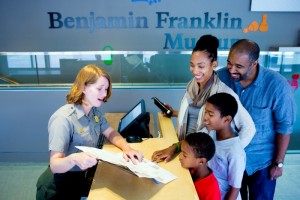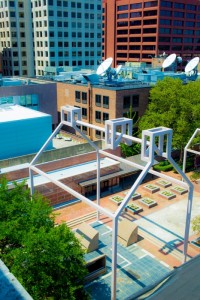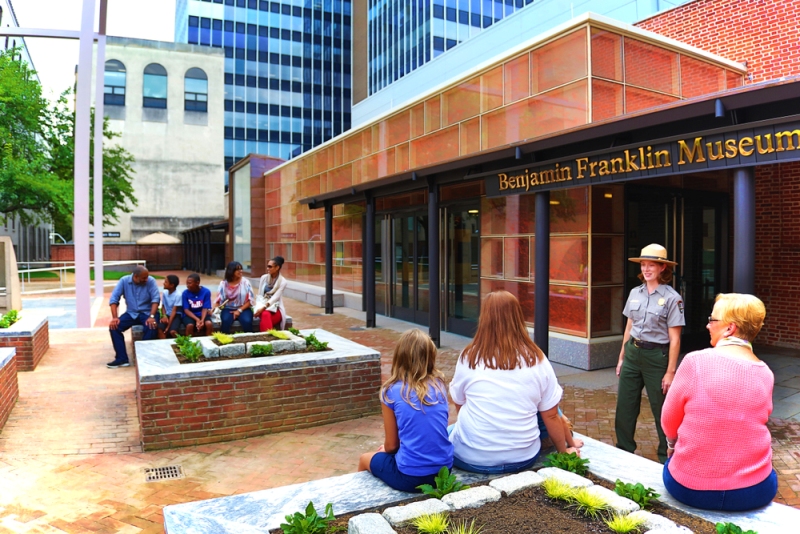By Phillip D. Johnson
When the new BenjaminFranklinMuseum opened in Philadelphia on Saturday, August 24, visitors were able to delve into all aspects of Franklin’s life, from his role as statesman and diplomat to his life as a private citizen, inventor, philosopher and more. Built next to the site where Franklin actually lived in the mid 1700s, the underground museum was originally built for the 1976 Bicentennial celebration. The Benjamin Franklin Museum in Independence National Historical Park is re-opening to the public after a two year renovation project. Visitors are invited to Museum Preview Days, August 24 through September 19. The Grand Opening for the museum will be September 20, following a reception on September 19 organized by the Friends of Independence National Historical Park.
Dedicated to the life, times and legacy of Benjamin Franklin, the revitalized museum features personal artifacts, computer animations and interactive displays exploring Franklin’s life and character. Visitors of all ages will be able to immerse themselves in the 18th century life of the passionate, industrious and rebellious Benjamin Franklin.
“We intentionally created this museum to generate discussion, to make visitors think about how Franklin embodied the best of the spirit of the 18th century and how his character and ideas are still relevant today,” said Cynthia MacLeod, superintendent of Independence National Historical Park. “This is a museum that people will want to come back to again and again, a new gem under the much-treasured and award-winning Franklin Court designed for 1976 by Venturi, Rauch, and Scott Brown.”
“This dynamic new exhibit space casts Benjamin Franklin’s contributions in a whole new light, not only providing visitors and residents a greater understanding of who Franklin was, but also inspiring future generations to imagine a little of Ben’s passion and inventiveness in themselves,” said Michael Dahl, senior vice president at The Pew Charitable Trusts.
“The museum tells Ben Franklin’s story in a delightful, compelling way,” said Meryl Levitz, President & CEO of the Greater Philadelphia Tourism Marketing Corporation. “It will leave visitors with a deeper connection to the man whose ideas they’ll see reflected throughout the city.”
Throughout Philadelphia, visitors can follow Benjamin Franklin’s legacy at the places he worked (Independence Hall), the institutions he founded (American Philosophical Society), the attractions named after him (The Franklin Institute) and in the public art he inspired (Bolt of Lightning…A Memorial to Benjamin Franklin).
This project was made possible through a public-private partnership of the National Park Service with The Pew Charitable Trusts, H.F. Gerry Lenfest, the William Penn Foundation, the John S. and James L. Knight Foundation, the Commonwealth of Pennsylvania, the City of Philadelphia, the Independence Visitor Center Corporation, and Eastern National.
About the Exhibits
 Benjamin Franklin – the relevant revolutionary – was revolutionary in his thinking and actions. Franklin’s presence can be felt throughout Independence National Historical Park, from Independence Square – where he served in the Continental Congress and the Constitutional Convention – to Franklin Court, where his Philadelphia home and printing office once stood. That house is no longer standing, but an iconic “ghost house” structure, created by internationally renowned architects Robert Venturi and John Rauch, with Denise Scott Brown, brings it to life.
Benjamin Franklin – the relevant revolutionary – was revolutionary in his thinking and actions. Franklin’s presence can be felt throughout Independence National Historical Park, from Independence Square – where he served in the Continental Congress and the Constitutional Convention – to Franklin Court, where his Philadelphia home and printing office once stood. That house is no longer standing, but an iconic “ghost house” structure, created by internationally renowned architects Robert Venturi and John Rauch, with Denise Scott Brown, brings it to life.
The Benjamin Franklin Museum includes:
45 historical artifacts, mostly 18th-century (with a few 19th & early-20th-century exceptions)
Oldest artifact: Mastodon tooth fossil – Fossilized stone/Independence National Historical Park. This tooth, found at Franklin Court in 1959, likely was among a group of fossils sent to Franklin in London in 1767. Franklin found the fossils “extremely curious.” Discovered near the Ohio River, they came from a mastodon, an ancient, elephant-like creature.
Largest artifact: Sedan Chair (French or Italian), ca. 1750–1780 – Wood, metal / Chester County Historical Society. Franklin was the oldest member of the Constitutional Convention in 1787. Ill and suffering excruciating pain, he was sometimes transported in a sedan chair by prisoners from the nearby Walnut Street jail. Sedan chairs were popular in Europe in the 18th century.
Smallest artifact: (One of the pieces from the] Chess set (French), 1750–1780 Pearwood/American Philosophical Society, Philadelphia). Originally owned by Benjamin Franklin, Franklin loved chess, and played friendly yet competitive matches with numerous opponents throughout his life. The grandson of a friend in Paris wrote that Franklin’s “passion for late-night games was checked only by his supply of candles.”
Most electrifying artifact: Electrical Apparatus (American), 1742-1747 – Walnut and iron/Library Company of Philadelphia. Originally owned and designed by Benjamin Franklin and made by Philadelphia-area craftsmen, including the Wistarburgh Glassworks, N.J., Franklin and his fellow gentleman scientists used this to generate electricity for use in their many electrical experiments.
Individual rooms in the museum reflect different aspects of Franklin’s personality, focusing on five distinct character traits. While the 20,000 square foot museum can be toured in any order, visitors can explore the following rooms:
ARDENT & DUTIFUL: “Man is a sociable being.” Naturally charming and witty, Franklin drew people to him wherever he lived. He was dutiful and affectionate toward his family but it was his close friends both here and in Europe to whom he expressed his most ardent devotion. Visitors will see Franklin’s personal items on display, including the Franklin family bible and armchairs once used in Franklin’s home. Children will enjoy using a computer-animated game to play Franklin’s musical invention, the glass armonica.
AMBITIOUS & REBELLIOUS: “Be frugal and industrious, and you will be free.” Although Franklin’s ambition and rebelliousness were judged as negative traits, he rose quickly through the social and political ranks of 18th century society. His natural intelligence, hard work and restless energy won him many friends. Displays in this room focus on his early career as a printer and postmaster. Objects presented in this exhibit include several printing and publishing artifacts like The Pennsylvania Gazette and the Bill of Lading. Of note is a special animation entitled “At the Cockpit” which allows visitors to stand beside a life-size Franklin as he is summoned to appear before the British Privy Council on accusations of inciting riots against the crown. Many historians have viewed this incident as a turning point in Franklin’s opinion toward possible separation from England.
MOTIVATED TO IMPROVE: “What good have I done today?” Franklin believed in bettering himself and the world around him. This room explores his many contributions to society such as improved street lamp designs, and the creation of the Franklin stove and bifocals. Original artifacts reveal his involvement in the creation of public institutions such as lending libraries, firefighting companies, and establishment of the University of Pennsylvania and schools for enslaved children. A large, multi-player, touch screen computer interactive exhibit allows visitors to learn about Franklin’s many community improvements – and see how good they are at applying those ideas themselves.
CURIOUS & FULL OF WONDER: “A thirst for knowledge.” From the time he was a boy to his very last days, Franklin delighted in learning new things. He closely observed the natural world around him, frequently sharing his findings and sense of discovery with others. His curiosity and scientific explorations mirrored the ideals of the Enlightenment. Visitors can see examples of Franklin’s scientific equipment and experiments through artifacts and video animations. Young people will enjoy hearing other young people explain the complex scientific topics that Franklin and his colleagues studied. Hands-on touch objects display Franklin’s inventions and observations made during long sea voyages that connect past technologies with the present.
STRATEGIC & PERSUASIVE: “Life is a kind of chess.” Franklin’s passion for playing chess also cultivated important personal traits such as strategic thinking and patience that helped him become an effective negotiator and diplomat. Visitors will learn about Franklin’s role in securing French support for the American Revolution and his skill at political problem solving. A large, multi-player, touch screen computer game called “Join or Die” allows visitors to select a puzzle piece from the famous cartoon, answer a question and then fit the piece back into place as the image comes alive. Visitors will also be able to examine Franklin’s views and actions regarding slavery and race. This element asks visitors to weigh the evidence and decide if Franklin supported slavery or wanted to abolish it.
The final area includes a room meant to evoke FRANKLIN’S LIBRARY, and a corridor with seating that allows visitors to consider his LEGACY. This exhibit uses computer animations and projections, as well as a stunning lighted wall to bring to mind Franklin’s last years at Franklin Court. Franklin began to write his autobiography in 1771 but never completed it. Instead of writing a complete memoir of his life, Franklin chose to focus on stories from his early life that he considered important lessons from which young people could learn. Visitors will eavesdrop on Franklin as he sits at his desk writing his autobiography and hear five stories included in the final version.
Just for Kids
 The museum offers a family guide through which parents, teachers and children can look for “Skuggs,” Franklin’s pet squirrel. Scattered throughout the exhibit, each Skuggs figure will ask questions and engage children with activities and games while learning about Franklin and 18th century life. Follow @SkuggsFranklin on Twitter to learn more about the museum, exhibits and activities that will be held there.
The museum offers a family guide through which parents, teachers and children can look for “Skuggs,” Franklin’s pet squirrel. Scattered throughout the exhibit, each Skuggs figure will ask questions and engage children with activities and games while learning about Franklin and 18th century life. Follow @SkuggsFranklin on Twitter to learn more about the museum, exhibits and activities that will be held there.
Overall, Interactives Exhibits include:
30 computer interactives and/or animations
11 hands-on and/or mechanical interactives (including touch objects)
5 hands-on, matching game interactives
4 flipbooks (with annotated excerpts of primary sources)
Audio-visual design/build contracts for interactive computer elements, videos and animation were awarded to Memory Collective (Plymouth, MA) and Blue Cadet (Philadelphia). Blue Cadet created imaginative animations and interactive exhibits such as the Armonica demonstration game and animations based on woodcuts by artist Charles Turzak, including the inspiring Library animations. Memory Collective created a variety of computer interactives including “Seeking Opportunity,” the “Join or Die” puzzle game, “Improving Communities” interactive, “Family and Friends” portraits and numerous video animations relating stories from Franklin’s life in his own words.
Exhibits were fabricated by Kubik Maltbie (New Jersey). The construction contract was awarded to the Daniel J. Keating Company (Pennsylvania). National Park Service staff worked closely with QuinnEvans (architects) and CassonMann (exhibit designers) along with a wide array of special consultants for HVAC, electrical, IT, security, sound, and lighting design.
Guest curators, Remer and Talbott (Pennsylvania), provided research and writing for exhibit content and were closely involved in the development of all videos and computer and contributed a variety of reproduction artifacts, images and ideas from the Benjamin Franklin Tercentenary’s travelling exhibit. Dan Bosin Associates and the Independence Visitor Center Corporation helped manage exhibit contracts and coordinated with National Park Service project managers. Artifacts on display in the museum include items on loan from museums around the country as well as items from the collection of Independence National Historical Park.
Visiting the Museum
 The new facility will have a museum store, managed by , with books and other merchandise related to Franklin and colonial Philadelphia. Entrance to the BenjaminFranklinMuseum will require a $5 fee ($2 for children under 16, and free for school groups with advance reservations). The exhibits and videos are open-captioned with audio descriptive and listening assistive devices available. The museum is completely handicapped accessible. More information about visiting the museum can be found at www.nps.gov/inde.
The new facility will have a museum store, managed by , with books and other merchandise related to Franklin and colonial Philadelphia. Entrance to the BenjaminFranklinMuseum will require a $5 fee ($2 for children under 16, and free for school groups with advance reservations). The exhibits and videos are open-captioned with audio descriptive and listening assistive devices available. The museum is completely handicapped accessible. More information about visiting the museum can be found at www.nps.gov/inde.
A unit of the National Park Service, Independence National Historical Parkwas created by an Act of Congress on June 28, 1948. Accredited by the American Association of Museums, Independence NHP covers almost 54 acres in Philadelphia’s Old City, and includes Independence Hall, the Liberty Bell, Congress Hall, Franklin Court, and other historic buildings associated with the founding of the United States. The park is open from 9:00 am daily with the exception of Christmas day. A visit to Independence National Historical Park should start at the Independence Visitor Center, located at 6th and Market Streets. Here, visitors can pick up a park brochure, park map, and the free, timed tickets required for Independence Hall. For more information visit the park’s website, http://www.nps.gov/inde or follow us at twitter.com/independencenhp.


